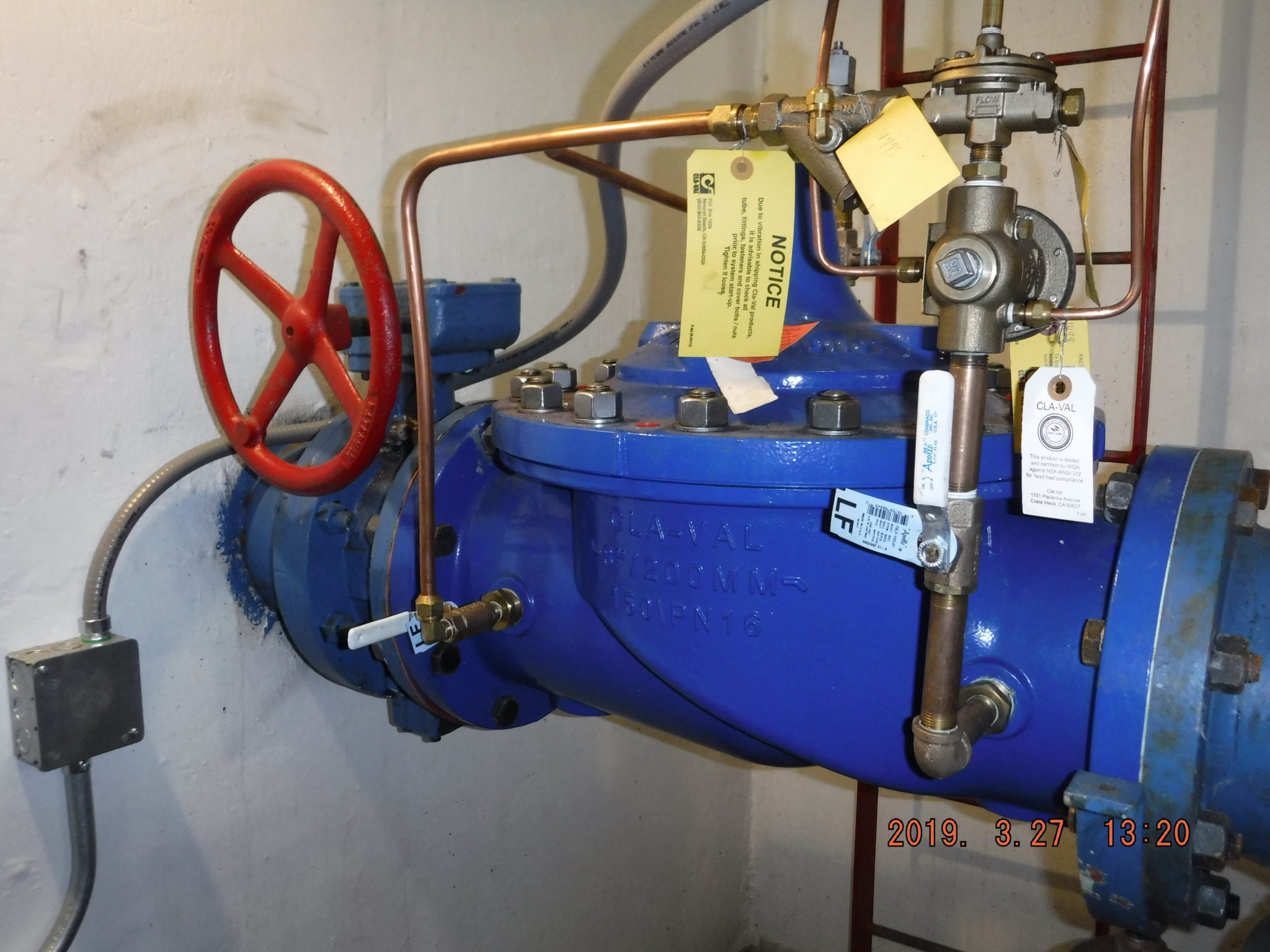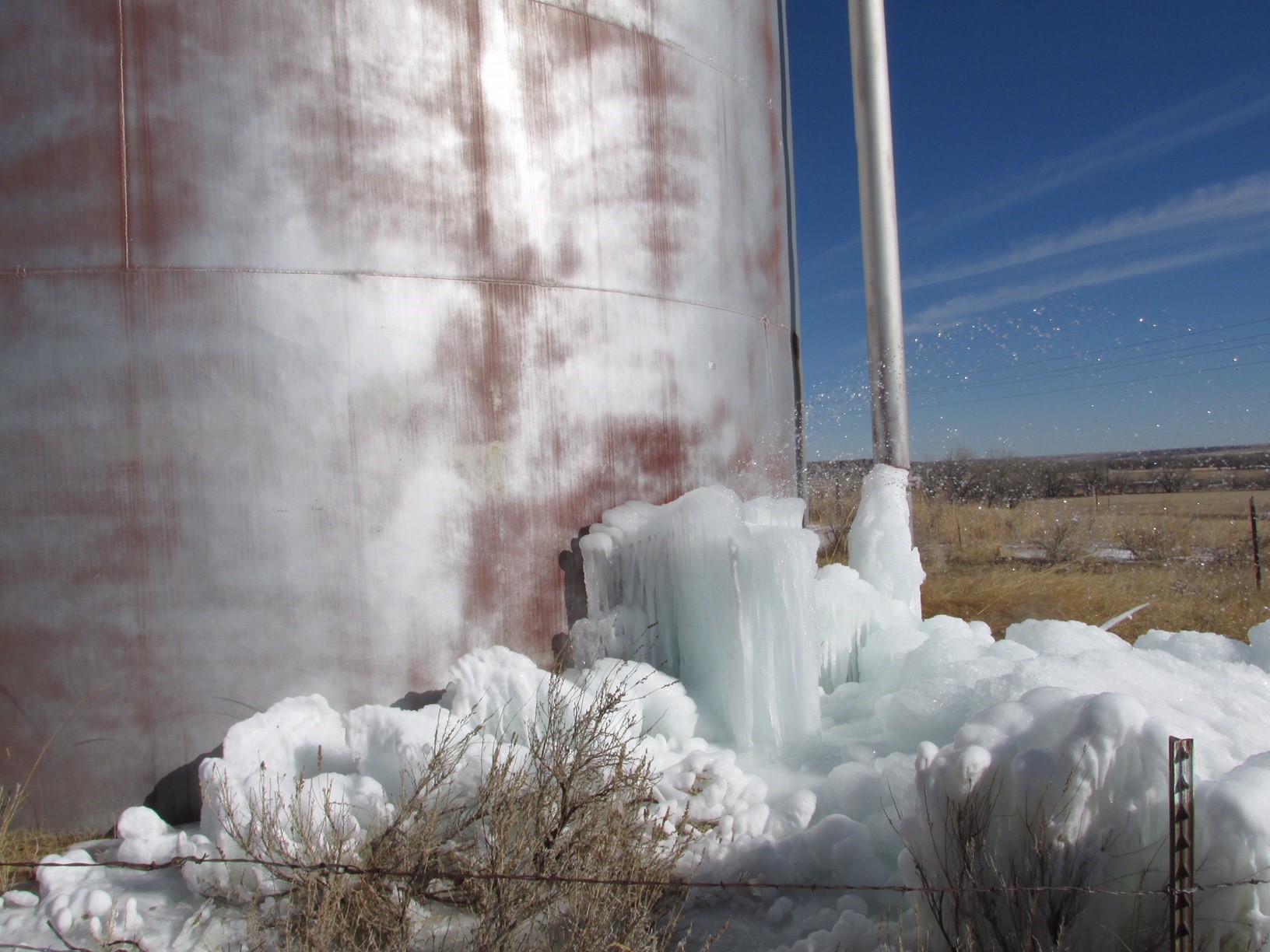In an ideal world, every water system would be equipped with a back-up of every component in the system including water supply, pumps, treatment, distribution/transmission mains, storage tanks, etc. However, many systems do not have this luxury, and it is not always practical in the real world for a variety of reasons, oftentimes simply due to being cost prohibitive.
What if your water system has only one water storage tank, and the tank needs to be taken offline for maintenance, repair, or replacement? How can you safely and effectively continue to provide safe drinking water to your customers while not putting your water system infrastructure at risk?

Leaking Water Tank Requiring Bypass to Address Problem
The good news is there is almost always an effective solution! The bad news is there is not a simple one size fits all solution that can be applied to all communities. Potential solutions should evaluate the operations of the water system as a whole and how the tank impacts those operations. A few of the more common questions to evaluate might include:
- What are the primary functions of the tank (i.e. provide peak water demands, fire flow storage, maintain distribution system pressures)?
- Is the tank needed for part of the treatment process (i.e. provide chlorine contact time)?
- Is water pumped or gravity fed to and from the tank?
- What time of year will the water tank be out of service? What will water demands be during that time of year?
- What other controls and safeguards are present within the system?
- How long will the tank be out of service?
- How often do you need to take your tank offline?
Answers to these questions can help to narrow down potential solutions as to what may or may not work for your system. It will also be necessary to consider whether it would be advantageous to consider only temporary bypass options or to consider a more permanent solution.

Existing Controls May Need Adjusted For Temporary Bypass
Temporary Bypass
A temporary bypass solution may be required in either an emergency or if taking the tank offline is infrequent such as for normal tank repair and maintenance. In cold weather climates, the season the tank is to be offline can significantly impact potential bypass options. If the tank is expected to be offline during warm weather months as is common for tank coating, water usage may be higher and there may be bigger peaks of water usage that need to be taken into consideration. Freezing could be a concern if the tank is expected to be offline during cold weather months.
Some potential means of temporary bypass include the following:
- Utilizing existing system – The water system may be capable of running as is without physically adding any components if it is temporary and the correct safety provisions are already in place. If water supply will be pumped into the distribution directly, it is important to make sure existing pressure relief valves are in place and operational. It will also be important to ensure that there is enough flexibility in the amount of water that is pumped such that the pumps are not cycling excessively for long periods of time (i.e. more than one pump and pumps automatically kick on or off). It may also be necessary and/or helpful to adjust the controls on the system to allow a wider pressure range to help prevent excessive pump cycling. Adjusting existing VFDs, if present, for a wider range of pressures/flows from individual pumps would also aid in preventing frequent pump on/off.
- Add temporary pressure control – Water storage tanks not only help to maintain distribution system pressures, but they are also a good fail-safe for building excessive pressures within the system. With the water storage tank offline, it may be necessary to install temporary pressure control. This could be as simple as some temporary piping and a pressure relief valve set up on a fire hydrant if there are no weather constraints.
- Add temporary storage – Temporary storage could consist of any means of adding volume to the system (i.e. an actual storage tank or large diameter piping that holds a larger volume of water). Ideally the temporary storage would be placed at the same location/elevation as the existing water storage tank to simplify operations. Sometimes that is not practical, and storage may need to be added elsewhere in the system. In this case, pumped storage and/or additional controls may need to be added as well.
- Add temporary pumps/motor controls – It may be necessary to provide either temporary pumping or add variable frequency drives to the pumps.

Permanent Bypass Valve
Permanent Bypass
A permanent bypass solution oftentimes will have the least impact to system operations as it is specifically designed to work as seamlessly as possible with your water system. The biggest disadvantage of permanent bypass solution is that it typically comes with the highest cost.
Some of the more common permanent bypass solutions that are incorporated into water systems include the following:
- Bypass Control Valves – Bypass control valves could consist of pressure sustaining valves, pressure reducing valves, pressure relief valves, flow control valves, or a combination of these. These types of control valves are typically installed on a bypass line in a vault or small building. Most control valves that would be utilized for bypass control would be mechanically automated and would be calibrated to the specific system at the time of installation. Ways to utilize the control valve could be as simple as manually turning a few valves or incorporating into a larger SCADA system.
- Bypass Water Storage Tank – A permanent bypass water storage tank consists of a small water storage tank that can help to maintain both water system pressures as well as supplement the water supply to meet peak demands. These tanks do not provide fire flow storage. Depending upon the environment and location to be utilized, the tank could be a small above ground tank or a small buried tank, such as a buried fiberglass tank.
- New Redundant Water Storage Tank – A new redundant tank would be the most expensive option but would also provide the best long-term benefits for providing a sustainable, resilient, and safe drinking water supply. A redundant tank would boost operation and fire flow storage while ensuring adequate system pressures can be maintained even with one tank offline.
There are numerous solutions that can be utilized either as a standalone option or in conjunction with another option that can help keep your system operational if your water storage tank needs to be taken offline. Ultimately, your system should be evaluated for its unique situation, and you need to be provided with the best options for your water system to help you to maintain safe drinking water to your customers.
If you are unsure of the impacts of taking your tank offline or if you have questions or concerns about any of temporary or permanent bypass solutions, Great West Engineering can help. Contact us today to speak with one of our water tank specialists.
LATEST NEWS
Holiday Spirit in Action – Great West’s Commitment to Giving
As the holiday season approaches, one of the highlights is our fundraising efforts to support local families in need. Since 2015, this has been an annual tradition at Great West Engineering, and it’s truly heartwarming to see our staff come together to contribute to...
Basin Creek Dam #1 Rehabilitation
Basin Creek Dam #1, is nestled in the foothills of the Highland Mountains about 10 miles south of Butte, Montana. The reservoir serves as a critical source of municipal drinking water for the City-County of Butte-Silver Bow (BSB), providing nearly two-thirds of the...
Solid Waste Utility Rates – How to Set Fair and Equitable Rates for Your Community
Establishing appropriate utility rates is crucial for providing sustainable solid waste management services. Like any public utility, sanitation is an essential service that is critical to our society. Typically, a solid waste utility for a city or county is operated...




